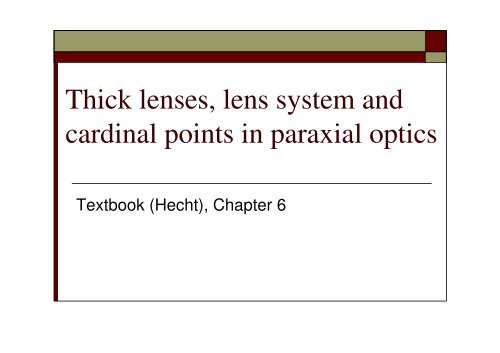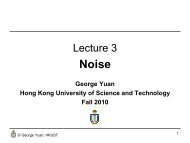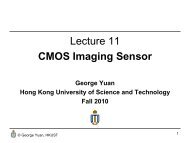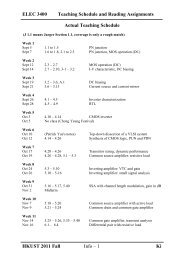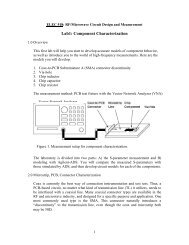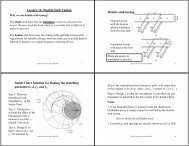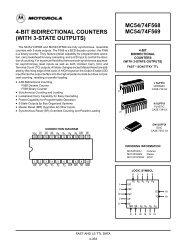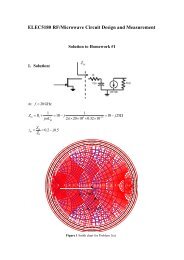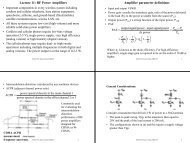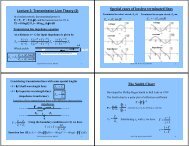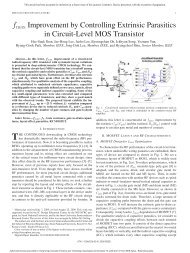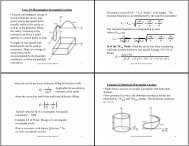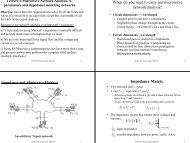Thick lenses, lens system and cardinal points in paraxial optics
Thick lenses, lens system and cardinal points in paraxial optics
Thick lenses, lens system and cardinal points in paraxial optics
You also want an ePaper? Increase the reach of your titles
YUMPU automatically turns print PDFs into web optimized ePapers that Google loves.
<strong>Thick</strong> <strong><strong>lens</strong>es</strong>, <strong>lens</strong> <strong>system</strong> <strong>and</strong><br />
<strong>card<strong>in</strong>al</strong> <strong>po<strong>in</strong>ts</strong> <strong>in</strong> <strong>paraxial</strong> <strong>optics</strong><br />
Textbook (Hecht), Chapter 6
Image Formation Summary Table
Complex optical <strong>system</strong>: <strong>Thick</strong> <strong>lens</strong><br />
<strong>Thick</strong> <strong><strong>lens</strong>es</strong>, comb<strong>in</strong>ations of <strong><strong>lens</strong>es</strong> etc..<br />
Consider case where t is NOT<br />
negligible.<br />
We would like to ma<strong>in</strong>ta<strong>in</strong> our<br />
Gaussian imag<strong>in</strong>g relation<br />
n n’<br />
n<br />
s<br />
n'<br />
+<br />
s '<br />
=<br />
P<br />
t<br />
n L<br />
But where do we measure s, s’ s ; f, f’ f<br />
from? How do we determ<strong>in</strong>e P?<br />
We try to develop a formalism that<br />
can be used with any <strong>system</strong>!!
Card<strong>in</strong>al <strong>po<strong>in</strong>ts</strong> <strong>and</strong> planes:<br />
The <strong>card<strong>in</strong>al</strong> <strong>po<strong>in</strong>ts</strong> <strong>and</strong> the associated <strong>card<strong>in</strong>al</strong> planes<br />
are a set of special <strong>po<strong>in</strong>ts</strong> <strong>and</strong> planes <strong>in</strong> an optical <strong>system</strong>,<br />
which help <strong>in</strong> the analysis of its <strong>paraxial</strong> properties.<br />
The analysis of an optical <strong>system</strong> us<strong>in</strong>g <strong>card<strong>in</strong>al</strong> <strong>po<strong>in</strong>ts</strong> is<br />
known as gaussian <strong>optics</strong>, named after Carl Friedrich<br />
Gauss.<br />
The <strong>card<strong>in</strong>al</strong> <strong>po<strong>in</strong>ts</strong> <strong>and</strong> planes of an optical <strong>system</strong> <strong>in</strong>clude:<br />
- The focal <strong>po<strong>in</strong>ts</strong> <strong>and</strong> focal planes<br />
- The pr<strong>in</strong>cipal planes <strong>and</strong> pr<strong>in</strong>cipal <strong>po<strong>in</strong>ts</strong><br />
- The surface vertices (or vertexes)<br />
- The nodal <strong>po<strong>in</strong>ts</strong>
Card<strong>in</strong>al <strong>po<strong>in</strong>ts</strong> <strong>and</strong> planes:<br />
Focal <strong>po<strong>in</strong>ts</strong> <strong>and</strong> planes<br />
The front focal po<strong>in</strong>t of an optical <strong>system</strong>, by def<strong>in</strong>ition, has the<br />
property that any ray that passes through it will emerge from<br />
the <strong>system</strong> parallel to the optical axis.<br />
The rear (or back) focal po<strong>in</strong>t of the <strong>system</strong> has the reverse<br />
property: rays that enter the <strong>system</strong> parallel to the optical axis<br />
are focused such that they pass through the rear focal po<strong>in</strong>t.<br />
The front <strong>and</strong> rear (or back) focal planes are def<strong>in</strong>ed as the<br />
planes, perpendicular to the optic axis, which pass through the<br />
front <strong>and</strong> rear focal <strong>po<strong>in</strong>ts</strong>. An object <strong>in</strong> <strong>in</strong>f<strong>in</strong>ite distance away<br />
from the optical <strong>system</strong> forms an image at the rear focal plane.<br />
For objects a f<strong>in</strong>ite distance away, the image is formed at a<br />
different location, but rays that leave the object parallel to one<br />
another cross at the rear focal plane.
Th<strong>in</strong> Lens<br />
AIR<br />
In <strong>paraxial</strong> region<br />
h1≈h2<br />
Focal Po<strong>in</strong>t<br />
F<br />
h2<br />
R<br />
R<br />
h1<br />
n<br />
(Glass)<br />
Collimated Beam<br />
(Parallel to the OA)<br />
Optical Axis<br />
(OA)<br />
Collimated Beam<br />
(Parallel to the OA)<br />
How do we<br />
measure the focal length?<br />
<strong>Thick</strong> Lens<br />
AIR<br />
h1>h2<br />
Focal Po<strong>in</strong>t<br />
F = ?<br />
h2<br />
R<br />
n<br />
(Glass)<br />
R<br />
h1<br />
Collimated Beam<br />
(Parallel to the OA)<br />
Optical Axis<br />
(OA)<br />
Collimated Beam<br />
(Parallel to the OA)
<strong>Thick</strong> Lens: F measured from the center of the <strong>lens</strong>?<br />
F1<br />
AIR<br />
h 2<br />
h 1<br />
= h’ 1<br />
; h 2<br />
= h’ 2<br />
R<br />
R<br />
n<br />
h 1<br />
(Glass)<br />
Focal Po<strong>in</strong>t<br />
L1<br />
Collimated Beam<br />
(Parallel to the OA)<br />
Optical Axis<br />
(OA)<br />
Collimated Beam<br />
(Parallel to the OA)<br />
AIR<br />
F2<br />
Collimated Beam<br />
(Parallel to the OA)<br />
Focal Po<strong>in</strong>t<br />
It seems F2 > F1.<br />
Is this correct?<br />
h’ 2<br />
R<br />
n<br />
(Glass)<br />
L2<br />
h’ 1<br />
R<br />
Optical Axis<br />
(OA)<br />
Collimated Beam<br />
(Parallel to the OA)
<strong>Thick</strong> Lens: Def<strong>in</strong>e Pr<strong>in</strong>cipal Planes<br />
AIR<br />
First<br />
Focal Po<strong>in</strong>t<br />
F1<br />
R<br />
First Pr<strong>in</strong>cipal Plane (FPP)<br />
(Primary Pr<strong>in</strong>cipal Plane)<br />
n<br />
(Glass)<br />
R<br />
Collimated Beam<br />
(Parallel to the OA)<br />
Optical Axis<br />
(OA)<br />
Collimated Beam<br />
(Parallel to the OA)<br />
First Pr<strong>in</strong>cipal Po<strong>in</strong>t<br />
(FPP ⊥ OA)
<strong>Thick</strong> Lens: Def<strong>in</strong>e Pr<strong>in</strong>cipal Planes<br />
Second Pr<strong>in</strong>cipal Plane (SPP)<br />
(Secondary Pr<strong>in</strong>cipal Plane)<br />
Collimated Beam<br />
(Parallel to the OA)<br />
F2<br />
AIR<br />
Optical Axis<br />
(OA)<br />
Collimated Beam<br />
(Parallel to the OA)<br />
R<br />
n<br />
(Glass)<br />
R<br />
Second Focal Po<strong>in</strong>t<br />
Second Pr<strong>in</strong>cipal Po<strong>in</strong>t<br />
(SPP ⊥ OA)
<strong>Thick</strong> Lens: Def<strong>in</strong>e Pr<strong>in</strong>cipal Planes<br />
F1 = F2<br />
F1<br />
F2<br />
AIR<br />
Optical Axis<br />
(OA)<br />
First<br />
Focal Po<strong>in</strong>t<br />
R<br />
n<br />
(Glass)<br />
R<br />
Second<br />
Focal Po<strong>in</strong>t<br />
First Pr<strong>in</strong>cipal Plane (FPP)<br />
(Primary Pr<strong>in</strong>cipal Plane)<br />
Second Pr<strong>in</strong>cipal Plane (FPP)<br />
(Secondary Pr<strong>in</strong>cipal Plane)
<strong>Thick</strong> Lens: Front <strong>and</strong> Back Focal Length<br />
First Pr<strong>in</strong>cipal Plane (FPP)<br />
F1<br />
Second Pr<strong>in</strong>cipal Plane (FPP)<br />
F2<br />
AIR<br />
Optical Axis<br />
(OA)<br />
R<br />
n<br />
(Glass)<br />
R<br />
First<br />
Focal Po<strong>in</strong>t<br />
Second<br />
Focal Po<strong>in</strong>t<br />
Front Focal Length<br />
(Front Work<strong>in</strong>g Distance)<br />
Back Focal Length<br />
(Back Work<strong>in</strong>g Distance)
Card<strong>in</strong>al <strong>po<strong>in</strong>ts</strong> <strong>and</strong> planes:<br />
Pr<strong>in</strong>cipal planes <strong>and</strong> <strong>po<strong>in</strong>ts</strong><br />
• The two pr<strong>in</strong>cipal planes have the property that a ray emerg<strong>in</strong>g from the <strong>lens</strong><br />
appears to have crossed the rear pr<strong>in</strong>cipal plane at the same distance from the<br />
axis that that ray appeared to cross the front pr<strong>in</strong>cipal plane, as viewed from the<br />
front of the <strong>lens</strong>. In this model, rays travel parallel to the optical axis between<br />
pr<strong>in</strong>cipal planes. The pr<strong>in</strong>cipal planes are crucial <strong>in</strong> def<strong>in</strong><strong>in</strong>g the optical properties<br />
of the <strong>system</strong>, s<strong>in</strong>ce it is the distance of the object <strong>and</strong> image from the front <strong>and</strong><br />
rear pr<strong>in</strong>cipal planes that determ<strong>in</strong>es the magnification of the <strong>system</strong>. The<br />
pr<strong>in</strong>cipal <strong>po<strong>in</strong>ts</strong> are the <strong>po<strong>in</strong>ts</strong> where the pr<strong>in</strong>cipal planes cross the optical axis.<br />
• If the medium surround<strong>in</strong>g the optical <strong>system</strong> has a refractive <strong>in</strong>dex of 1 (e.g.<br />
air), then the distance from the pr<strong>in</strong>cipal planes to their correspond<strong>in</strong>g focal<br />
<strong>po<strong>in</strong>ts</strong> is just the focal length of the <strong>system</strong>. If the medium is not air or vacuum,<br />
the distance to the foci is multiplied by the <strong>in</strong>dex of refraction of the medium.<br />
• For a th<strong>in</strong> <strong>lens</strong> <strong>in</strong> air, the pr<strong>in</strong>cipal planes both lie at the location of the <strong>lens</strong>. The<br />
po<strong>in</strong>t where they cross the optical axis is sometimes mislead<strong>in</strong>gly called the<br />
optical centre of the <strong>lens</strong>. Note, however, that for a real <strong>lens</strong> the pr<strong>in</strong>cipal<br />
planes do not necessarily pass through the centre of the <strong>lens</strong>, <strong>and</strong> <strong>in</strong> general may<br />
not lie <strong>in</strong>side the <strong>lens</strong> at all.
Card<strong>in</strong>al <strong>po<strong>in</strong>ts</strong> <strong>and</strong> planes<br />
Surface vertices<br />
The surface vertices are the<br />
<strong>po<strong>in</strong>ts</strong> where each surface<br />
crosses the optical axis.<br />
They are important primarily<br />
because they are the physically<br />
measurable parameters for the<br />
position of the optical elements,<br />
<strong>and</strong> so the positions of the other<br />
<strong>card<strong>in</strong>al</strong> <strong>po<strong>in</strong>ts</strong> must be known<br />
with respect to the vertices to<br />
describe the physical <strong>system</strong>.
Card<strong>in</strong>al <strong>po<strong>in</strong>ts</strong> <strong>and</strong> planes:<br />
1. Nodal (N) <strong>po<strong>in</strong>ts</strong> <strong>and</strong> planes<br />
Nodal <strong>po<strong>in</strong>ts</strong><br />
The front <strong>and</strong> rear nodal <strong>po<strong>in</strong>ts</strong> have the property that a ray that<br />
passes through one of them will also pass through the other, <strong>and</strong><br />
with the same angle with respect to the optical axis. The nodal<br />
<strong>po<strong>in</strong>ts</strong> therefore do for angles what the pr<strong>in</strong>cipal planes do for<br />
transverse distance. If medium on both sides of the optical <strong>system</strong><br />
is the same (e.g. air), then the front <strong>and</strong> rear nodal <strong>po<strong>in</strong>ts</strong> co<strong>in</strong>cide<br />
with the front <strong>and</strong> rear pr<strong>in</strong>cipal planes, respectively.
Card<strong>in</strong>al <strong>po<strong>in</strong>ts</strong> <strong>and</strong> planes:<br />
1. Nodal (N) <strong>po<strong>in</strong>ts</strong> <strong>and</strong> planes<br />
n<br />
n’<br />
N 1<br />
N 2<br />
n L<br />
NP 1<br />
NP 2
Card<strong>in</strong>al planes of simple <strong>system</strong>s<br />
1. Th<strong>in</strong> <strong>lens</strong><br />
V’ <strong>and</strong> V co<strong>in</strong>cide <strong>and</strong><br />
V’<br />
V<br />
n<br />
n'<br />
+ '<br />
=<br />
P<br />
H, H’ H<br />
s<br />
s<br />
is obeyed.<br />
Pr<strong>in</strong>cipal planes, nodal planes,<br />
co<strong>in</strong>cide at center
Card<strong>in</strong>al planes of simple <strong>system</strong>s<br />
1. Spherical refract<strong>in</strong>g surface<br />
n<br />
V<br />
n’<br />
Gaussian imag<strong>in</strong>g formula<br />
obeyed, with all distances<br />
measured from V<br />
n<br />
n'<br />
+ '<br />
=<br />
P<br />
s<br />
s
Card<strong>in</strong>al <strong>po<strong>in</strong>ts</strong> <strong>and</strong> planes:<br />
1. Focal (F) <strong>po<strong>in</strong>ts</strong> & Pr<strong>in</strong>cipal planes (PP) <strong>and</strong> <strong>po<strong>in</strong>ts</strong><br />
R 1<br />
≠ R 2<br />
n n L<br />
n’<br />
F 2<br />
H 2<br />
ƒ’<br />
PP 2<br />
Keep def<strong>in</strong>ition of focal po<strong>in</strong>t ƒ’
Card<strong>in</strong>al <strong>po<strong>in</strong>ts</strong> <strong>and</strong> planes:<br />
1. Focal (F) <strong>po<strong>in</strong>ts</strong> & Pr<strong>in</strong>cipal planes (PP) <strong>and</strong> <strong>po<strong>in</strong>ts</strong><br />
R 1<br />
≠ R 2<br />
n n L<br />
n’<br />
F 1<br />
H 1<br />
ƒ<br />
PP 1<br />
Keep def<strong>in</strong>ition of focal po<strong>in</strong>t ƒ
Utility of pr<strong>in</strong>cipal planes<br />
Suppose s, s’, s , f, f’ f all measured from H 1 <strong>and</strong> H 2 …<br />
n n L<br />
n’<br />
h<br />
F 1<br />
F 2<br />
H 1<br />
H 2<br />
h’<br />
ƒ<br />
ƒ’<br />
s s’<br />
PP 1<br />
PP 2<br />
Show that we recover the Gaussian Imag<strong>in</strong>g relation:<br />
1 1 1<br />
+ =<br />
s s′<br />
f
Conjugate Planes – where y’=y<br />
n n L<br />
n’<br />
y<br />
F 1<br />
F 2<br />
H 1<br />
H 2<br />
y’<br />
ƒ<br />
ƒ’<br />
s s’<br />
PP 1<br />
PP 2
Card<strong>in</strong>al <strong>po<strong>in</strong>ts</strong> <strong>and</strong> planes:<br />
1. Focal (F) <strong>po<strong>in</strong>ts</strong> & Pr<strong>in</strong>cipal planes (PP) <strong>and</strong> <strong>po<strong>in</strong>ts</strong><br />
The distance h 1<br />
from the primary pr<strong>in</strong>cipal plane (P) to<br />
the on-axis entrance po<strong>in</strong>t of the <strong>lens</strong> (V), <strong>and</strong> the<br />
distance h 2<br />
from the secondary pr<strong>in</strong>cipal plane (P’) to the<br />
on-axis exit po<strong>in</strong>t (V’), are:<br />
Sign convention!<br />
(d l<br />
is the thickness of<br />
<strong>lens</strong>, f is focal length.)
Card<strong>in</strong>al <strong>po<strong>in</strong>ts</strong> <strong>and</strong> planes:<br />
1. Focal (F) <strong>po<strong>in</strong>ts</strong> & Pr<strong>in</strong>cipal planes (PP) <strong>and</strong> <strong>po<strong>in</strong>ts</strong><br />
Each <strong>paraxial</strong> focal po<strong>in</strong>t of a thick <strong>lens</strong> is located at a<br />
distance f from the nearer of the two pr<strong>in</strong>cipal planes.<br />
The <strong>lens</strong>maker’s equation for a thick <strong>lens</strong> immersed <strong>in</strong> air (n 0<br />
= 1) is
Card<strong>in</strong>al <strong>po<strong>in</strong>ts</strong> <strong>and</strong> planes:<br />
1. Focal (F) <strong>po<strong>in</strong>ts</strong> & Pr<strong>in</strong>cipal planes (PP) <strong>and</strong> <strong>po<strong>in</strong>ts</strong><br />
The <strong>paraxial</strong> object-image relation <strong>and</strong> Newton’s equation<br />
still hold if the object <strong>and</strong> image distances s , s’ are<br />
measured from the pr<strong>in</strong>cipal planes<br />
A rule-of-thumb for ord<strong>in</strong>ary glass <strong><strong>lens</strong>es</strong> <strong>in</strong> air is that the<br />
separation P-P’ roughly equals one-third the <strong>lens</strong> thickness<br />
V-V’.
<strong>Thick</strong> Lenses
<strong>Thick</strong> Lenses


